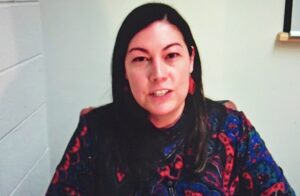Serpent River First Nation remains resilient in fight for toxic injustice

By Kelly Anne Smith
NORTH BAY— When government officials were invited to Serpent River First Nation to tour dead lakes, they refused to drink the coffee and tea. They were told not to worry; the beverages weren’t made from tailings pond water.
Dr. Lianne Leddy told her grandmother’s story during Nipissing University’s 2022 Anne Clendinning Memorial Lecture.
Leddy is the author of the new book, Serpent River Resurgence: Confronting Uranium Mining at Elliot Lake. Dr. Leddy is a member of Serpent River First Nation and associate professor in Indigenous Studies at Wilfred Laurier University.
Nipissing First Nation Elder John Sawyer opened the presentation.
“If we kill everything around us, then we lose. We die. It’s very important, when we listen, we listen actively. We put ourselves in that position and come up with changes. Maybe it’s a pause we need, stop. Maybe we need to stop until we figure it out.”
Leddy conducted interviews with Elders at Serpent River First Nation in 2008 and 2009.
“I had the absolute privilege to learn from my grandmother Gertrude Lewis, as well as Valerie Commanda, Arnelda Jacobs, Buddy Jacobs, Terry Jacobs and Peter Johnson.”
Leddy talked of being grateful for the Elders sharing their expertise and time with her.
“While consulting these records, while it was necessary in order to tell this story in a history monograph, it does not compare with sitting down at a kitchen table or in a living room and learning from people you know, engaging in conversation, sometimes sharing laughter in spite of the tough and oftentimes infuriating subject matter.”
Leddy grew up in Elliot Lake, situated on the traditional territory of Serpent River First Nation, where the importance of interacting with the land and water continues.
“The serpent that shares Anishinaabe territory is said to have a den where the mouth of the Serpent River meets Lake Huron.”
Traditional activities of Serpent River First Nation members included making maple syrup and trapping well into the 20th century. Ancestors practised agriculture and kept gardens for food.
“The Anishinabek on the north shore were hunting, fishing, growing potatoes and corn as well as trading furs,” she explained. “The development of the timber industry and arrival of the CPR railway started a pattern of extraction and land-leasing on our homeland that facilitated devastating mid-20th century effects once uranium was discovered by settlers.”
Many uranium mines and tailings ponds littered Serpent River land with toxic consequences. Leddy says by the 1950s, uranium was needed for nuclear weapons during the cold war. Canada signed an agreement with the United States for $1.6 billion to supply uranium.
The health of the watershed soon declined. The were many reports of lake trout caught in Elliot Lake and Big Quirke Lake that were not fit for consumption. They had a distinctive odour when cooked. Females were not releasing their eggs.
A 1964 government memo titled Radioactive pollution based on the Ontario Waterways Commission said that Lakes Quirke and Whiskey had ten times the radioactivity that was considered tolerable yet tourism fishing in the lakes were allowed.
Dr. Leddy asserts that government did not account for the continuation of pollution through dam failures at tailings sites, “not to mention the impact on traditional Anishinaabe uses of fish, wildlife and water.”
Serpent River First Nation Elder Terry Jacobs recalled how his father made his living hunting and trapping in the watershed until animals disappeared with industry pollution. Betty Jacobs remembered her father-in-law quit trapping when beaver fur was poor quality and the tails were breaking right off.
River contamination was hazardous to daily living. In 1976, after 20 years of living with uranium mines on their territory, Health and Welfare Canada finally advised that residents stop drinking water from their river.
Dr. Leddy read out her grandmother’s words about the Cutler acid plant built in the community. It produced sulphuric acid used in uranium mining.
“We thought there would be employment and our living would be better. We weren’t thinking of the destruction of our wildlife and trees and gardens that followed from the plant. We didn’t know about that. They didn’t tell us how it would effect anything.”
In 1987, Gertrude Lewis made a presentation to the federal government to have the toxic site cleaned up. The government blew up the plant but didn’t remove the toxins.
“As a band member of Serpent River band, I attended meetings in 1955 with representatives of Noranda mines and the Department of Indian Affairs. I can still hear Indian Affairs people telling us we had nothing to worry about.”
Sulphur fires would flare up during the summer. Dangerous dust fell and people had problems breathing with the smell. Windows couldn’t be opened in the hot summers. Metals on cars and nails on houses rusted. Roofs burned with sulphuric dust falling on houses. Clothes couldn’t be hung out to dry because of rust and holes. Children developed rashes swimming.
In protest, the resilient community brought waste from the site to the TransCanada Highway. Before Canada Day in 1988, fire was set to the toxic rubbish pile containing sulphur, pyrite, calcite, and cement. In national news, Chief Commanda said it could burn for days or months. People travelling in cars drove through the polluted smoke smelling of rotten eggs.
Finally, on July 20, 1988, the federal government promised to build a facility to neutralize the toxic waste with lime.
Dr. Lianne Leddy’s book details Gertrude Lewis touring dead lakes and how Elders elbowed their way to the table to have their say with government officials. Their activism brought Serpent River First Nation’s toxic plight to the world.


